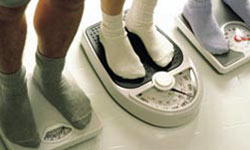Dieting is a war. The plate is the battlefield, and your favorite foods the enemy. Your comrades-at-arms? Depends on the diet.
Steak might be guarding your fork from the evil influence of fettuccine Alfredo, or a bowl of cabbage soup blocking your plate from, well, anything. Fellow soldiers in the form of a grim sea of grapefruits stand sentry against the invasion of ice cream.
Whatever happened to peace talks and diplomacy? Can’t spinach and garlic bread co-exist?
We say yes. Diets don’t have to be so drastic. If the lemonade diet sounds crazy, that’s because it is. You’ll definitely lose weight, but you won’t keep it off. The human body can’t sustain that kind of monotony. Your brain and belly will rebel.
So stop the insanity. Let’s bring harmony back to the dinner table — and figure out how to lose weight in a healthy, effective way that lasts.
Contents
- Flexitarian Diet
- Mediterranean Diet
- The Instinct Diet
- Step Diet
- Thin for Life
5: Flexitarian Diet
If you’ve ever thought about going veggie but just couldn’t part with spaghetti and meatballs, there’s an option for you: the Flexitarian Diet. As the name suggests, it’s a more flexible type of vegetarian eating.
This diet was dreamed up by Dawn Jackson Blatner, a registered dietitian who cites an April 2006 study in Nutrition Reviews that found vegetarians weigh, on average, 15 percent less than non-vegetarians. She also points to research published in the Annals of Internal Medicine on vegetarians having lower cholesterol and advice from the American Institute for Cancer Research on eating a plant-based diet to lower cancer rates. Oh, and according to the American Journal of Clinical Nutrition, vegetarians live about 3.6 years longer than the rest of us [source: Blatner].
Not a lot to argue with there.
Beginners start by cutting down to eating meat only five days a week, then cutting back to just two days if they choose. Many of us eat vegetarian meals already (grilled cheese, anyone?), so it’s not as hard as it sounds. Blatner provides a meal plan and sample meals that actually sound good — a peach and raspberry crepe, for example, is a snack. She also makes the point that there are a lot of delicious, healthy vegetarian ingredients that most of us haven’t been exposed to — sunflower seed butter, kefir, seaweed sprinkle. One of Blatner’s recommended foods is mochi, a Japanese rice cake made out of sticky (glutinous) rice. It’s often stuffed with some sort of sweet filling, like red bean paste.
The diet does still rely on calorie counting, which can be problematic. Study after study has shown that people underestimate the calories of what they eat. Luckily, in the age of the smartphone, you can download any number of apps to help you keep track.
4: Mediterranean Diet
Who wouldn’t want to spend time in the Greek Isles? While it sounds dreamy, you don’t need to sail to Santorini to eat like you enjoy a beautiful Mediterranean life — a life with a lower risk of heart disease, Parkinson’s, cancer and Alzheimer’s [source: Mayo Clinic].
Put the butter aside and reach for the extra-virgin olive oil. It tastes just as amazing on bread, on pasta and in your cooking. You’ll have to cut down on the red meat, but in return, you can indulge in a moderate amount of red wine. And you don’t have to go veggie — you’ll be grilling tuna, salmon or trout twice a week or so, because the omega-3s in those fatty fish will help ensure that your cardiovascular system stays clean and healthy.
Another easy switch? Swapping herbs and spices for salt for all the flavor with none of the sodium. A handful of nuts makes a good snack, and while they’re full of fat, it’s not the bad kind.
The basic idea is to eat lots of fruits, veggies, whole grains, beans, nuts, legumes and seeds. And if you’ve ever tried tahini, a sesame-seed paste you can use as a spread, the seeds should not be a problem.
While you’re savoring your smaller portions of herbed, olive-oil drizzled foods, remember that the people of the Mediterranean walk far more than those of us in most U.S. towns, so use it as inspiration for an after-dinner stroll.
Ancient Oils
The olive oil trade can be traced as far back as 1700 B.C., thanks to clay tablets found on the island of Crete [source: Vossen].
3: The Instinct Diet
The Instinct Diet has a major thing going for it: its author, Susan B. Roberts. She’s a nutrition and psychiatry professor at Tufts, she’s been overweight herself (by 55 pounds) and she used to be a chef.
Roberts points out that there are three centers in the brain that tell you when you’re hungry: satiety, reward and pleasure. As she told the Tufts Journal, "When people get hungry, they want to eat. If there’s food there, you eat it. If it’s got calories, you like it more. If there is more variety, you eat more" [source: Flaherty].
It all starts with a strategy for learning how to control your hunger. That doesn’t mean desperately trying to convince your stomach that you’ve eaten by chewing ice cubes and visualizing fullness. You get training wheels.
Instead of getting to the point where you’d trade your first-born to Rumpelstiltskin for a Snickers ice cream bar, find new foods to love that will make you feel full. That means high-fiber foods, high-protein foods, high-volume foods and low glycemic index carbs.
We realize that none of that sounds even remotely appetizing. But when you rephrase it as "a snack of cereal with chocolate melted over it," maybe you can see why this is an easier diet than most to follow.
Also, according to her research, average weight loss for those on the Instinct diet is 30 pounds over five to six months — and 90 percent of them maintained it.
Are you a supertaster?
A heightened sense of taste is genetic. Supertasters have a dominant allele for the gene TAS2R28, according to How Taste Works.
2: Step Diet
So you really want a Krispy Kreme doughnut. The "hot" sign is on in the window and your craving is officially impossible to deny.
On the Step Diet, you could eat that doughnut — 3/4 of it, anyway. You just have to park in the far corner of the parking lot and maybe do a couple of laps around it when you’re finished.
The bottom line: If you cut everything you eat by one quarter and walk 10,000 steps a day, you’ll lose weight. It’s that simple. And the man telling you that, James Hill, who co-founded the National Weight Control Registry, knows what he’s talking about.
The idea is that exercise doesn’t have to be as scary as a P90X commercial makes it seem. You don’t have to get "extreme" fit or "turbo" or "mega" anything. You just have to add more steps to your day. The only equipment you need is a cheap pedometer.
If you’re not much of a walker, there are charts to tell you what activities equal what number of steps. (For instance, an hour of yoga is 3,000 steps, if you’re the bendy type.)
And the weight loss facts? A pound or two a week.
Walk This Way
Thomas Jefferson did not, contrary to popular belief, invent the pedometer — Leonardo da Vinci did. But Jefferson had one that he loved and used all the time. He even sent one to his buddy James Madison [source: Welk].
1: Thin for Life
"Thin for Life" sounds nice, doesn’t it? Registered dietitian Anne M. Fletcher, a health and medical journalist, writes that it’s an attainable goal, and she has witnesses to prove it.
What makes her diet different is that it’s presented and supported by people who have lost at least 20 pounds on it — and kept it all off for at least three years. Someone who’s been where you’ve been is telling you the joys of "high flavor, low risk" foods. (Like jelly beans!)
She outlines some simple swaps — replacing oil with applesauce in baking, eggs with egg whites — and creates a plan week by week for you to modify your diet according to standards like the Food Guide Pyramid (recently replaced visually with MyPlate, but with the same content). You start with the easy stuff, like just focusing on all the sugar you consume, instead of trying to do everything all at once.
From her interviews with 160 people who successfully lost and kept off excess weight, sometimes after trying dozens of diets, Fletcher gleaned what she calls the 10 keys to success. She writes that, according to research she’s done on several studies and in her own experience, keeping weight off isn’t as impossible as so many people make it seem.
It may take a little longer to see a weight difference with these five diets than it does when you eat nothing but leek soup for a week, but it’s the kind of difference that sticks.
Sweet Treats
Jelly beans date back to the 1800s. According to Jelly Belly, there was an ad during the Civil War telling people to send jelly beans to their men in blue/gray [source: Jelly Belly].



















asthma medication field – asthma medication flash asthma treatment electric